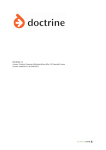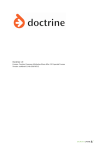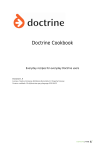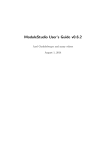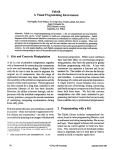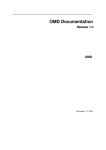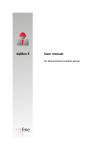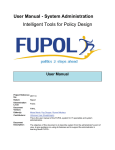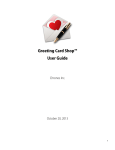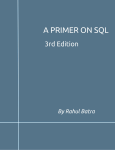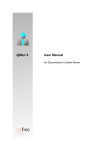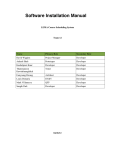Download Doctrine - Open Source PHP ORM
Transcript
Doctrine 1.1
License: Creative Commons Attribution-Share Alike 3.0 Unported License
Version: cookbook-1.1-pt_BR-2010-04-19
Table of Contents
ii
Table of Contents
My First Project................................................................................................. 3
Introduction ............................................................................................................... 3
Download ................................................................................................................... 3
Package Contents ...................................................................................................... 3
Running the CLI......................................................................................................... 4
Defining Schema........................................................................................................ 4
Test Data Fixtures ..................................................................................................... 5
Building Everything ................................................................................................... 5
Running Tests ............................................................................................................ 6
User CRUD ................................................................................................................ 8
symfony 1.1 and Doctrine ............................................................................... 10
Setup........................................................................................................................ 10
Setup Database........................................................................................................ 11
Setup Schema .......................................................................................................... 11
Build Database......................................................................................................... 12
Admin Generators.................................................................................................... 13
Helpful Links............................................................................................................ 14
symfony 1.1 and Doctrine Migrations............................................................. 16
Setting up your database......................................................................................... 16
Define your schema ................................................................................................. 16
Build Database......................................................................................................... 17
Setup Migration ....................................................................................................... 18
Run Migration.......................................................................................................... 21
Code Igniter and Doctrine .............................................................................. 23
Download Doctrine .................................................................................................. 23
Setup Doctrine......................................................................................................... 23
Setup Command Line Interface ............................................................................... 24
Start Using Doctrine................................................................................................ 26
Plug and Play Schema Information With Templates ...................................... 29
Taking Advantage of Column Aggregation Inheritance ................................. 31
-----------------
Brought to you by
Chapter 1: My First Project
3
Chapter 1
My First Project
Introduction
This is a tutorial & how-to on creating your first project using the fully featured PHP Doctrine
ORM. This tutorial
uses the the ready to go Doctrine sandbox package. It requires a web server, PHP and PDO +
Sqlite.
Download
To
get
started,
first
download
the
latest
Doctrine
sandbox
package:
1
http://www.phpdoctrine.org/download . Second, extract
the downloaded file and you should have a directory named Doctrine-x.x.x-Sandbox. Inside of
that directory is a simple
example implementation of a Doctrine based web application.
Package Contents
The files/directory structure should look like the following
$ cd Doctrine-0.10.1-Sandbox
$ ls
config.php
doctrine
index.php
data
doctrine.php
lib
Listing
1-1
migrations
models
schema
The sandbox does not require any configuration, it comes ready to use with a sqlite database.
Below is a description of
each of the files/directories and what its purpose is.
• doctrine - Shell script for executing the command line interface. Run with ./doctrine
to see a list of command or
./doctrine help to see a detailed list of the commands
• doctrine.php - Php script which implements the Doctrine command line interface
which is included in the above doctrine
1.
http://www.phpdoctrine.org/download
-----------------
Brought to you by
Chapter 1: My First Project
4
shell script
•
•
•
•
•
index.php - Front web controller for your web application
migrations - Folder for your migration classes
schema - Folder for your schema files
models - Folder for your model files
lib - Folder for the Doctrine core library files
Running the CLI
If you execute the doctrine shell script from the command line it will output the following:
Listing
1-2
$ ./doctrine
Doctrine Command Line Interface
./doctrine
./doctrine
./doctrine
./doctrine
./doctrine
./doctrine
./doctrine
./doctrine
./doctrine
./doctrine
./doctrine
./doctrine
./doctrine
./doctrine
./doctrine
./doctrine
./doctrine
./doctrine
./doctrine
./doctrine
build-all
build-all-load
build-all-reload
compile
create-db
create-tables
dql
drop-db
dump-data
generate-migration
generate-migrations-db
generate-migrations-models
generate-models-db
generate-models-yaml
generate-sql
generate-yaml-db
generate-yaml-models
load-data
migrate
rebuild-db
Defining Schema
Below is a sample yaml schema file to get started. You can place the yaml file in schemas/
schema.yml. The command
line interface looks for all *.yml files in the schemas folder.
Listing
1-3
--User:
columns:
id:
primary: true
autoincrement: true
type: integer(4)
username: string(255)
password: string(255)
relations:
Groups:
class: Group
refClass: UserGroup
-----------------
Brought to you by
Chapter 1: My First Project
5
foreignAlias: Users
Group:
tableName: groups
columns:
id:
primary: true
autoincrement: true
type: integer(4)
name: string(255)
UserGroup:
columns:
user_id: integer(4)
group_id: integer(4)
relations:
User:
onDelete: CASCADE
Group:
onDelete: CASCADE
Test Data Fixtures
Below is a sample yaml data fixtures file. You can place this file in data/fixtures/data.yml. The
command line
interface looks for all *.yml files in the data/fixtures folder.
--User:
zyne:
username: zYnepassword: changeme
Groups: [founder, lead, documentation]
jwage:
username: jwage
password: changeme
Groups: [lead, documentation]
Listing
1-4
Group:
founder:
name: Founder
lead:
name: Lead
documentation:
name: Documentation
Building Everything
Now that you have written your schema files and data fixtures, you can now build everything
and begin working with your
models . Run the command below and your models will be generated in the models folder.
$ ./doctrine build-all-reload
build-all-reload - Are you sure you wish to drop your databases? (y/n)
y
-----------------
Brought to you by
Listing
1-5
Chapter 1: My First Project
6
build-all-reload - Successfully dropped database for connection "sandbox"
at path "/Users/jwage/Sites/doctrine/branches/0.10/tools/sandbox/
sandbox.db"
build-all-reload - Generated models successfully from YAML schema
build-all-reload - Successfully created database for connection "sandbox"
at path "/Users/jwage/Sites/doctrine/branches/0.10/tools/sandbox/
sandbox.db"
build-all-reload - Created tables successfully
build-all-reload - Data was successfully loaded
Take a peak in the models folder and you will see that the model classes were generated for
you. Now you can begin coding
in your index.php to play with Doctrine itself. Inside index.php place some code like the
following for a simple test.
Running Tests
Listing
1-6
$query = new Doctrine_Query();
$query->from('User u, u.Groups g');
$users = $query->execute();
echo '<pre>';
print_r($users->toArray(true));
The print_r() should output the following data. You will notice that this is the data that we
populated by placing
the yaml file in the data/fixtures files. You can add more data to the fixtures and rerun the
build-all-reload
command to reinitialize the database.
Listing
1-7
Array
(
[0] => Array
(
[id] => 1
[username] => zYne[password] => changeme
[Groups] => Array
(
[0] => Array
(
[id] => 1
[name] => Founder
)
[1] => Array
(
[id] => 2
[name] => Lead
)
[2] => Array
(
[id] => 3
[name] => Documentation
-----------------
Brought to you by
Chapter 1: My First Project
7
)
)
)
[1] => Array
(
[id] => 2
[username] => jwage
[password] => changeme
[Groups] => Array
(
[0] => Array
(
[id] => 2
[name] => Lead
)
[1] => Array
(
[id] => 3
[name] => Documentation
)
)
)
)
You can also issue DQL queries directly to your database by using the dql command line
function. It is used like the
following.
jwage:sandbox jwage$ ./doctrine dql "FROM User u, u.Groups g"
dql - executing: "FROM User u, u.Groups g" ()
dql - dql id: 1
dql username: zYnedql password: changeme
dql Groups:
dql dql id: 1
dql name: Founder
dql dql id: 2
dql name: Lead
dql dql id: 3
dql name: Documentation
dql - dql id: 2
dql username: jwage
dql password: changeme
dql Groups:
dql dql id: 2
-----------------
Brought to you by
Listing
1-8
Chapter 1: My First Project
dql
dql
dql
dql
-
8
name: Lead
id: 3
name: Documentation
User CRUD
Now we can demonstrate how to implement Doctrine in to a super simple module for
managing users and passwords. Place
the following code in your index.php and pull it up in your browser. You will see the simple
application.
Listing
1-9
require_once('config.php');
Doctrine::loadModels('models');
$module = isset($_REQUEST['module']) ? $_REQUEST['module']:'users';
$action = isset($_REQUEST['action']) ? $_REQUEST['action']:'list';
if ($module == 'users') {
$userId = isset($_REQUEST['id']) && $_REQUEST['id'] > 0 ?
$_REQUEST['id']:null;
$userTable = Doctrine::getTable('User');
if ($userId === null) {
$user = new User();
} else {
$user = $userTable->find($userId);
}
switch ($action) {
case 'edit':
case 'add':
echo '<form action="index.php?module=users&action=save"
method="POST">
<fieldset>
<legend>User</legend>
<input type="hidden" name="id" value="' . $user->id .
'" />
<label for="username">Username</label> <input
type="text" name="user[username]" value="' . $user->username . '" />
<label for="password">Password</label> <input
type="text" name="user[password]" value="' . $user->password . '" />
<input type="submit" name="save" value="Save" />
</fieldset
</form>';
break;
case 'save':
$user->merge($_REQUEST['user']);
$user->save();
header('location: index.php?module=users&action=edit&id=' .
$user->id);
break;
case 'delete':
$user->delete();
-----------------
Brought to you by
Chapter 1: My First Project
9
header('location: index.php?module=users&action=list');
break;
default:
$query = new Doctrine_Query();
$query->from('User u')
->orderby('u.username');
$users = $query->execute();
echo '<ul>';
foreach ($users as $user) {
echo '<li><a href="index.php?module=users&action=edit&id='
. $user->id . '">' . $user->username . '</a> <a
href="index.php?module=users&action=delete&id=' . $user->id .
'">[X]</a></li>';
}
echo '</ul>';
}
echo '<ul>
<li><a href="index.php?module=users&action=add">Add</a></li>
<li><a href="index.php?module=users&action=list">List</a></li>
</ul>';
} else {
throw new Exception('Invalid module');
}
-----------------
Brought to you by
Chapter 2: symfony 1.1 and Doctrine
10
Chapter 2
symfony 1.1 and Doctrine
So, you want to give Doctrine a try with symfony 1.1 eh? First we will need to setup a new
symfony 1.1 project and install the sfDoctrinePlugin for 1.1. Execute the following commands
below and continue reading:
Setup
Listing
2-1
$ mkdir symfony1.1Doctrine
$ cd symfony1.1Doctrine
$ /path/to/symfony generate:project symfony1.1Doctrine
$ svn co http://svn.symfony-project.com/plugins/sfDoctrinePlugin/trunk
plugins/sfDoctrinePlugin
$ php symfony cc
Now, type the following command to list all the new commands that `sfDoctrinePlugin`
provides. You will notice that it gives you all the same commands as `sfPropelPlugin` and lots
more!
Listing
2-2
$ php symfony list doctrine
Available tasks for the "doctrine" namespace:
:build-all
Generates Doctrine model, SQL and
initializes the database (doctrine-build-all)
:build-all-load
Generates Doctrine model, SQL, initializes
database, and load data (doctrine-build-all-load)
:build-all-reload
Generates Doctrine model, SQL, initializes
database, and load data (doctrine-build-all-reload)
:build-all-reload-test-all
Generates Doctrine model, SQL, initializes
database, load data and run all test suites
(doctrine-build-all-reload-test-all)
:build-db
Creates database for current model
(doctrine-build-db)
:build-forms
Creates form classes for the current model
(doctrine-build-forms)
:build-model
Creates classes for the current model
(doctrine-build-model)
:build-schema
Creates a schema.xml from an existing
database (doctrine-build-schema)
:build-sql
Creates SQL for the current model
(doctrine-build-sql)
:data-dump
Dumps data to the fixtures directory
(doctrine-dump-data)
:data-load
Loads data from fixtures directory
-----------------
Brought to you by
Chapter 2: symfony 1.1 and Doctrine
11
(doctrine-load-data)
:dql
Execute a DQL query and view the results
(doctrine-dql)
:drop-db
Drops database for current model
(doctrine-drop-db)
:generate-crud
Generates a Doctrine CRUD module
(doctrine-generate-crud)
:generate-migration
Generate migration class
(doctrine-generate-migration)
:generate-migrations-db
Generate migration classes from existing
database connections (doctrine-generate-migrations-db,
doctrine-gen-migrations-from-db)
:generate-migrations-models Generate migration classes from an existing
set of models (doctrine-generate-migrations-models,
doctrine-gen-migrations-from-models)
:init-admin
Initializes a Doctrine admin module
(doctrine-init-admin)
:insert-sql
Inserts SQL for current model
(doctrine-insert-sql)
:migrate
Migrates database to current/specified
version (doctrine-migrate)
:rebuild-db
Creates database for current model
(doctrine-rebuild-db)
First, `sfDoctrinePlugin` currently requires that at least one application be setup, so lets just
instantiate a `frontend` application now.
$ php symfony generate:app frontend
Listing
2-3
Setup Database
Now lets setup our database configuration in `config/databases.yml`. Open the file in your
favorite editor and place the YAML below inside. For this test we are simply using a SQLite
database. Doctrine is able to create the SQLite database at the `config/doctrine.db` path for
you which we will do once we setup our schema and some data fixtures.
--all:
doctrine:
class:
param:
dsn:
Listing
2-4
sfDoctrineDatabase
sqlite
Setup Schema
Now that we have our database configured, lets define our YAML schema files in `config/
doctrine/schema.yml`. In this example we are setting up a simple `BlogPost` model which
`hasMany` `Tags`.
--BlogPost:
actAs:
Sluggable:
fields: [title]
-----------------
Listing
2-5
Brought to you by
Chapter 2: symfony 1.1 and Doctrine
12
Timestampable:
columns:
title: string(255)
body: clob
author: string(255)
relations:
Tags:
class: Tag
refClass: BlogPostTag
foreignAlias: BlogPosts
BlogPostTag:
columns:
blog_post_id:
type: integer
primary: true
tag_id:
type: integer
primary: true
Tag:
actAs: [Timestampable]
columns:
name: string(255)
Now that we have our Doctrine schema defined, lets create some test data fixtures in `data/
fixtures/data.yml`. Open the file in your favorite editor and paste the below YAML in to the
file.
Listing
2-6
--BlogPost:
BlogPost_1:
title: symfony + Doctrine
body:
symfony and Doctrine are great!
author: Jonathan H. Wage
Tags:
[symfony, doctrine, php]
Tag:
symfony:
name: symfony
doctrine:
name: doctrine
php:
name: php
Build Database
Ok, now for the fun stuff. We have our schema, and we have some data fixtures, so lets run
one single Doctrine command and create your database, generate your models, create tables
and load the data fixtures.
Listing
2-7
$ php symfony doctrine-build-all-reload frontend
>> doctrine Are you sure you wish to drop your databases? (y/n)
y
>> doctrine Successfully dropped database f...1.1Doctrine/config/
doctrine.db"
-----------------
Brought to you by
Chapter 2: symfony 1.1 and Doctrine
>> doctrine
doctrine.db"
>> doctrine
>> doctrine
>> doctrine
13
Successfully created database f...1.1Doctrine/config/
Generated models successfully
Created tables successfully
Data was successfully loaded
Now your `doctrine.db` SQLite database is created, all the tables for your schema were
created, and the data fixtures were populated in to the tables. Now lets do a little playing
around with the data to see how we can use the Doctrine Query Language to retrieve data.
$ php symfony doctrine:dql frontend "FROM BlogPost p, p.Tags t"
>> doctrine executing: "FROM BlogPost p, p.Tags t" ()
>> doctrine >> doctrine
id: 1
>> doctrine
title: symfony + Doctrine
>> doctrine
body: symfony and Doctrine are great!
>> doctrine
author: Jonathan H. Wage
>> doctrine
slug: symfony-doctrine
>> doctrine
created_at: 2008-06-16 12:28:57
>> doctrine
updated_at: 2008-06-16 12:28:57
>> doctrine
Tags:
>> doctrine
>> doctrine
id: 1
>> doctrine
name: symfony
>> doctrine
created_at: 2008-06-16 12:28:57
>> doctrine
updated_at: 2008-06-16 12:28:57
>> doctrine
>> doctrine
id: 2
>> doctrine
name: doctrine
>> doctrine
created_at: 2008-06-16 12:28:57
>> doctrine
updated_at: 2008-06-16 12:28:57
>> doctrine
>> doctrine
id: 3
>> doctrine
name: php
>> doctrine
created_at: 2008-06-16 12:28:57
>> doctrine
updated_at: 2008-06-16 12:28:57
Listing
2-8
Now, lets do a little explaining of the data that was returned. As you can see the models have
a created_at, updated_at and slug column which were not defined in the schema files. These
columns are added by the behaviors attached to the schema information under the actAs
setting. The `created_at` and `updated_at` column are automatically set `onInsert` and
`onUpdate`, and the slug column is a url friendly string that is created from the value of the
name column. Doctrine has a few behaviors that are included in core such as `Sluggable` and
`Timestampable`, but the behavior system is built to allow anyone to easily write behaviors
for their models to re-use over and over.
Admin Generators
Now we have our data model all setup and populated with some test fixtures so lets generate
an admin generator to manage the blog posts and tags.
$ php symfony doctrine:init-admin frontend blog_posts BlogPost
$ php symfony doctrine:init-admin frontend tags Tag
Now go open up your web browser and check out the `frontend` application and the
`blog_posts` and `tags` modules. It should be located at a url like the following:
-----------------
Brought to you by
Listing
2-9
Chapter 2: symfony 1.1 and Doctrine
Listing
2-10
14
http://localhost/symfony1.1Doctrine/web/frontend_dev.php/blog_posts
http://localhost/symfony1.1Doctrine/web/frontend_dev.php/tags
Now, with a little configuration of the blog post admin generator, we can control the
associated blog post tags by checking checkboxes when editing a blog post. Open `apps/
frontend/modules/blog_posts/config/generator.yml` and replace the contents with the YAML
from below.
Listing
2-11
--generator:
class:
param:
model_class:
theme:
list:
display:
object_actions:
_edit:
_delete:
edit:
display:
fields:
author:
type:
title:
type:
body:
type:
params:
Tags:
type:
params:
sfDoctrineAdminGenerator
BlogPost
default
[=title, author]
[author, title, body, Tags]
input_tag
input_tag
textarea_tag
size=50x10
doctrine_admin_check_list
through_class=BlogPostTag
Now refresh the blog post list and you will see it is cleaned up a little bit. Edit a blog post by
clicking the edit icon or the title and you can see below you can check the tags associated to
the blog post.
All of the features you get in Propel work 99% the same way with Doctrine, so it should be
fairly easy to get the hang of if you are coming from propel. sfDoctrinePlugin implements all
the same functionality as sfPropelPlugin as well as several additional features which
sfPropelPlugin is not capable of. Below you can find some more information on the major
features that Doctrine supports:
Helpful Links
• Behaviors
http://www.phpdoctrine.org/documentation/manual/
2
0_11?chapter=plugins - Easily create reusable behaviors for your Doctrine models.
• Migrations
http://www.phpdoctrine.org/documentation/manual/
3
0_11?chapter=migration - Deploy database schema changes to your production
environment through a programmatic interface.
http://www.phpdoctrine.org/documentation/manual/0_11?chapter=plugins
http://www.phpdoctrine.org/documentation/manual/
0_11?chapter=migration
2.
3.
-----------------
Brought to you by
Chapter 2: symfony 1.1 and Doctrine
15
• Doctrine Query Language - http://www.phpdoctrine.org/documentation/manual/
0_11?chapter=dql-doctrine-query-language4 - Build your database queries through a
fluent OO interface
• Validators
http://www.phpdoctrine.org/documentation/manual/
0_11?chapter=basic-schema-mapping#constraints-and-validators5 - Turn on column
validators for both database and code level validation.
• Hierarchical
Data
http://www.phpdoctrine.org/documentation/manual/
0_11?chapter=hierarchical-data6 - Turn your models in to nested sets easily with the
flip of a switch.
• Caching http://www.phpdoctrine.org/documentation/manual/0_11?chapter=caching7
- Tune performance by caching your DQL query parsing and the result sets of
queries.
If this short tutorial sparked your interest in Doctrine you can check out some other Doctrine
resources below to learn more about Doctrine:
• Full User Manual - http://www.phpdoctrine.org/documentation/manual/0_11?onepage8
• API Documentation - http://www.phpdoctrine.org/documentation/api/0_11 9
• Cheatsheet - http://www.phpdoctrine.org/Doctrine-Cheat-Sheet.pdf10
• Blog - http://www.phpdoctrine.org/blog11
• Community - http://www.phpdoctrine.org/community12
• Frequently Asked Questions - http://www.phpdoctrine.org/faq13
• Download - http://www.phpdoctrine.org/download14
http://www.phpdoctrine.org/documentation/manual/0_11?chapter=dqldoctrine-query-language
5. http://www.phpdoctrine.org/documentation/manual/0_11?chapter=basicschema-mapping#constraints-and-validators
6. http://www.phpdoctrine.org/documentation/manual/
0_11?chapter=hierarchical-data
7. http://www.phpdoctrine.org/documentation/manual/0_11?chapter=caching
8. http://www.phpdoctrine.org/documentation/manual/0_11?one-page
9. http://www.phpdoctrine.org/documentation/api/0_11
10. http://www.phpdoctrine.org/Doctrine-Cheat-Sheet.pdf
11. http://www.phpdoctrine.org/blog
12. http://www.phpdoctrine.org/community
13. http://www.phpdoctrine.org/faq
14. http://www.phpdoctrine.org/download
4.
-----------------
Brought to you by
Chapter 3: symfony 1.1 and Doctrine Migrations
16
Chapter 3
symfony 1.1 and Doctrine
Migrations
The PHP Doctrine ORM offers a fully featured database migration utility that makes it easy to
upgrade your databases for both schema and
data changes without having to manually write or keep up with SQL statements.
Database migrations essentially allow you to have multiple versions of your schema. A single
Doctrine migration class represents one
version of the schema. Each migration class must have an up() and a down() method defined
and the down() must negate everything done in
the up() method. Below I will show you an example of how to use Doctrine to control your
database.
Listing
3-1
This tutorial is written for symfony 1.1 but the same functionality exists
for the 1.0 version of sfDoctrinePlugin but in the 1.0
style task system.
Setting up your database
First thing we need to do is define your database and create it. Edit config/databases.yml and
setup your mysql database. Copy and
paste the yaml below in to the file.
Listing
3-2
--all:
doctrine:
class:
param:
dsn:
sfDoctrineDatabase
mysql
Define your schema
In this example we are going to use a traditional Blog model. Open config/doctrine/
schema.yml and copy and paste the yaml contents from
below in to the file.
Listing
3-3
--BlogPost:
actAs:
-----------------
Brought to you by
Chapter 3: symfony 1.1 and Doctrine Migrations
17
Sluggable:
fields: [title]
columns:
title: string(255)
body: clob
author: string(255)
relations:
Tags:
class: Tag
refClass: BlogPostTag
foreignAlias: BlogPosts
BlogPostTag:
columns:
blog_post_id:
type: integer
primary: true
tag_id:
type: integer
primary: true
Tag:
columns:
name: string(255)
Place the below data fixtures in to data/fixtures/data.yml
--BlogPost:
BlogPost_1:
slug: symfony-doctrine
author: Jonathan H. Wage
title: symfony + Doctrine
body: symfony and Doctrine are great!
Tags: [symfony, doctrine, php]
Listing
3-4
Tag:
symfony:
name: symfony
doctrine:
name: doctrine
php:
name: php
Build Database
Now with one simple command Doctrine is able to create the database, the tables and load
the data fixtures for you. Doctrine works
with any [PDO](http://www.php.net/pdo15) driver and is able to drop and create databases for
any of them.
$ ./symfony doctrine-build-all-reload frontend
>> doctrine Are you sure you wish to drop your databases? (y/n)
y
15.
http://www.php.net/pdo
-----------------
Brought to you by
Listing
3-5
Chapter 3: symfony 1.1 and Doctrine Migrations
>> doctrine
doctrine.db"
>> doctrine
doctrine.db"
>> doctrine
>> doctrine
>> doctrine
18
Successfully dropped database f...1.1Doctrine/config/
Successfully created database f...1.1Doctrine/config/
Generated models successfully
Created tables successfully
Data was successfully loaded
Now your database, models and tables are created for you so easily. Lets run a simple DQL
query to see the current data that is in the
database so we can compare it to the data after the migration has been performed.
Listing
3-6
$ ./symfony doctrine-dql frontend "FROM BlogPost p, p.Tags t"
>> doctrine executing: "FROM BlogPost p, p.Tags t" ()
>> doctrine >> doctrine
id: 1
>> doctrine
title: symfony + Doctrine
>> doctrine
body: symfony and Doctrine are great!
>> doctrine
author: Jonathan H. Wage
>> doctrine
slug: symfony-doctrine
>> doctrine
Tags:
>> doctrine
>> doctrine
id: 1
>> doctrine
name: symfony
>> doctrine
>> doctrine
id: 2
>> doctrine
name: doctrine
>> doctrine
>> doctrine
id: 3
>> doctrine
name: php
Setup Migration
Now what if a few months later you want to change the schema to split out the
BlogPost.author column to an Author model that is related
to BlogPost.author_id. First lets add the new model to your config/doctrine/schema.yml.
Replace your schema yaml with the schema
information from below.
Listing
3-7
--BlogPost:
actAs:
Sluggable:
fields: [title]
columns:
title: string(255)
body: clob
author: string(255)
author_id: integer
relations:
Author:
foreignAlias: BlogPosts
Tags:
class: Tag
refClass: BlogPostTag
foreignAlias: BlogPosts
-----------------
Brought to you by
Chapter 3: symfony 1.1 and Doctrine Migrations
19
BlogPostTag:
columns:
blog_post_id:
type: integer
primary: true
tag_id:
type: integer
primary: true
Tag:
columns:
name: string(255)
Author:
columns:
name: string(255)
Rebuild your models now with the following command.
$ ./symfony doctrine-build-model
>> doctrine Generated models successfully
Listing
3-8
As you see we have added a new Author model, and changed the author column to author_id
and integer for a foreign key to the Author
model. Now lets write a new migration class to upgrade the existing database without losing
any data. Run the following commands
to create skeleton migration classes in lib/migration/doctrine. You will see a file generated
named 001_add_author.class.php and
002_migrate_author.class.php. Inside them are blank up() and down() method for you to code
your migrations for the schema changes above.
$ ./symfony doctrine:generate-migration frontend AddAuthor
>> doctrine Generated migration class: AddA...Doctrine/lib/migration/
doctrine
$ ./symfony doctrine:generate-migration frontend MigrateAuthor
>> doctrine Generated migration class: Migr...Doctrine/lib/migration/
doctrine
Listing
3-9
Now we have 2 blank migration skeletons to write our migration code in. Below I have
provided the code to migrate the author column
to an Author model and automatically relate blog posts to the newly created author id.
// 001_add_author.class.php
/**
* This class has been auto-generated by the Doctrine ORM
*/
class AddAuthor extends Doctrine_Migration
{
public function up()
{
// Create new author table
$columns = array('id'
=> array('type'
=>
'length'
=>
'autoincrement' =>
'name' => array('type'
=>
'length'
=>
-----------------
Listing
3-10
Framework
'integer',
4,
true),
'string',
255));
Brought to you by
Chapter 3: symfony 1.1 and Doctrine Migrations
20
$this->createTable('author', $columns, array('primary' =>
array('id')));
// Add author_id to the blog_post table
$this->addColumn('blog_post', 'author_id', 'integer', array('length'
=> 4));
}
public function down()
{
// Remove author table
$this->dropTable('author');
// Remove author_id column from blog_post table
$this->removeColumn('blog_post', 'author_id');
}
}
// 002_migrate_author.class.php
/**
* This class has been auto-generated by the Doctrine ORM Framework
*/
class MigrateAuthor extends Doctrine_Migration
{
public function preUp()
{
$q = Doctrine_Query::create()
->select('p.id, p.author')
->from('BlogPost p');
$blogPosts = $q->execute();
foreach ($blogPosts as $blogPost)
{
$author =
Doctrine::getTable('Author')->findOneByName($blogPost->author);
if ( ! ($author instanceof Author && $author->exists()))
{
$author = new Author();
$author->name = $blogPost->author;
$author->save();
}
$blogPost->author_id = $author->id;
$blogPost->save();
}
}
public function up()
{
$this->removeColumn('blog_post', 'author');
}
public function down()
{
$this->addColumn('blog_post', 'author', 'string', array('length' =>
255));
}
}
-----------------
Brought to you by
Chapter 3: symfony 1.1 and Doctrine Migrations
21
Now run the following command and Doctrine will automatically perform the migration
process and update the database.
Run Migration
$ ./symfony doctrine-migrate frontend
>> doctrine migrated successfully to version #2
Listing
3-11
Now the database is updated with the new schema information and data migrated. Give it a
check and you will see that we have a new
author table, the blog_post.author column is gone and we have a new blog_post.author_id
column that is set to the appropriate author
id value.
The #2 migration removed the author column from the blog_post table, but we left it in the
model definition so that while it still
existed, before the #2 migration began we copied the contents of the author column to the
author table and related the blog_post to
the author id. You can now remove the author: string(255) column definition from the config/
doctrine/schema.yml and rebuild the models.
Here is the new BlogPost model definition.
--BlogPost:
actAs:
Sluggable:
fields: [title]
columns:
title: string(255)
body: clob
author_id: integer
relations:
Author:
foreignAlias: BlogPosts
Tags:
class: Tag
refClass: BlogPostTag
foreignAlias: BlogPosts
Listing
3-12
Re-build the models now since we removed the author column from the model definition and
the table in the database.
$ ./symfony doctrine-build-model
>> doctrine Generated models successfully
Listing
3-13
Now lets run a DQL query from the command line to see the final product.
$ ./symfony doctrine:dql frontend "FROM BlogPost p, p.Tags, p.Author a"
>> doctrine executing: "FROM BlogPost p, p.Tags, p.Author a" ()
>> doctrine >> doctrine
id: 1
>> doctrine
title: symfony + Doctrine
>> doctrine
body: symfony and Doctrine are great!
>> doctrine
author_id: 1
>> doctrine
slug: symfony-doctrine
>> doctrine
Tags:
-----------------
Brought to you by
Listing
3-14
Chapter 3: symfony 1.1 and Doctrine Migrations
>>
>>
>>
>>
>>
>>
>>
>>
>>
>>
>>
>>
doctrine
doctrine
doctrine
doctrine
doctrine
doctrine
doctrine
doctrine
doctrine
doctrine
doctrine
doctrine
22
id: 1
name: symfony
id: 2
name: doctrine
id: 3
name: php
Author:
id: 1
name: Jonathan H. Wage
If you compare the data returned here, to the data that was returned in the beginning of this
tutorial you will see that the author
column was removed and migrated to an Author model.
-----------------
Brought to you by
Chapter 4: Code Igniter and Doctrine
23
Chapter 4
Code Igniter and Doctrine
This tutorial will get you started using Doctrine with Code Igniter
Download Doctrine
First we must get the source of Doctrine from svn and place it in the system/database folder.
$ cd system/database
$ svn co http://svn.phpdoctrine.org/branches/0.11/lib doctrine
$ cd ..
Listing
4-1
// If you use svn in your project you can set Doctrine
// as an external so you receive bug fixes automatically from svn
$ svn propedit svn:externals database
// In your favorite editor add the following line
// doctrine http://svn.phpdoctrine.org/branches/0.11/lib
Setup Doctrine
Now we must setup the configuration for Doctrine and load it in system/application/config/
database.php
$ vi application/config/database.php
Listing
4-2
The code below needs to be added under this line of code
$db['default']['cachedir'] = "";
Listing
4-3
Add this code
// Create dsn from the info above
$db['default']['dsn'] = $db['default']['dbdriver'] .
'://' . $db['default']['username'] .
':' . $db['default']['password'].
'@' . $db['default']['hostname'] .
'/' . $db['default']['database'];
// Require Doctrine.php
require_once(realpath(dirname(__FILE__) . '/../..') . DIRECTORY_SEPARATOR
. 'database/doctrine/Doctrine.php');
-----------------
Brought to you by
Listing
4-4
Chapter 4: Code Igniter and Doctrine
24
// Set the autoloader
spl_autoload_register(array('Doctrine', 'autoload'));
// Load the Doctrine connection
Doctrine_Manager::connection($db['default']['dsn'],
$db['default']['database']);
// Set the model loading to conservative/lazy loading
Doctrine_Manager::getInstance()->setAttribute('model_loading',
'conservative');
// Load the models for the autoloader
Doctrine::loadModels(realpath(dirname(__FILE__) . '/..') .
DIRECTORY_SEPARATOR . 'models');
Now we must make sure system/application/config/database.php is included in your front
controller. Open your front controller in your favorite text editor.
Listing
4-5
$ cd ..
$ vi index.php
Change the last 2 lines of code of index.php with the following
Listing
4-6
require_once APPPATH.'config/database.php';
require_once BASEPATH.'codeigniter/CodeIgniter'.EXT;
Setup Command Line Interface
Create the following file: system/application/doctrine and chmod the file so it can be
executed. Place the code below in to the doctrine file.
Listing
4-7
$ vi system/application/doctrine
Place this code in system/application/doctrine
Listing
4-8
#!/usr/bin/env php
define('BASEPATH','.'); // mockup that this app was executed from ci ;)
chdir(dirname(__FILE__));
include('doctrine.php');
Now create the following file: system/application/doctrine.php. Place the code below in to the
doctrine.php file.
Listing
4-9
require_once('config/database.php');
// Configure Doctrine Cli
// Normally these are arguments to the cli tasks but if they are set here
the arguments will be auto-filled
$config = array('data_fixtures_path' => dirname(__FILE__) .
DIRECTORY_SEPARATOR . '/fixtures',
'models_path'
=> dirname(__FILE__) .
DIRECTORY_SEPARATOR . '/models',
'migrations_path'
=> dirname(__FILE__) .
DIRECTORY_SEPARATOR . '/migrations',
'sql_path'
=> dirname(__FILE__) .
-----------------
Brought to you by
Chapter 4: Code Igniter and Doctrine
DIRECTORY_SEPARATOR . '/sql',
'yaml_schema_path'
DIRECTORY_SEPARATOR . '/schema');
25
=>
dirname(__FILE__) .
$cli = new Doctrine_Cli($config);
$cli->run($_SERVER['argv']);
Now we must create all the directories for Doctrine to use
// Create directory for your yaml data fixtures files
$ mkdir system/application/fixtures
Listing
4-10
// Create directory for your migration classes
$ mkdir system/application/migrations
// Create directory for your yaml schema files
$ mkdir system/application/schema
// Create directory to generate your sql to create the database in
$ mkdir system/application/sql
Now you have a command line interface ready to go. If you execute the doctrine shell script
with no argument you will get a list of available commands
$ cd system/application
$ ./doctrine
Doctrine Command Line Interface
./doctrine
./doctrine
./doctrine
./doctrine
./doctrine
./doctrine
./doctrine
./doctrine
./doctrine
./doctrine
./doctrine
./doctrine
./doctrine
./doctrine
./doctrine
./doctrine
./doctrine
./doctrine
./doctrine
./doctrine
$
Listing
4-11
build-all
build-all-load
build-all-reload
compile
create-db
create-tables
dql
drop-db
dump-data
generate-migration
generate-migrations-db
generate-migrations-models
generate-models-db
generate-models-yaml
generate-sql
generate-yaml-db
generate-yaml-models
load-data
migrate
rebuild-db
On Microsoft Windows, call the script via the PHP binary (because the script won't invoke it
automatically:
php.exe doctrine
Listing
4-12
-----------------
Brought to you by
Chapter 4: Code Igniter and Doctrine
26
Start Using Doctrine
It is simple to start using Doctrine now. First we must create a yaml schema file.
(save it at schema with filename like : user.yml)
Listing
4-13
--User:
columns:
id:
primary: true
autoincrement: true
type: integer(4)
username: string(255)
password: string(255)
relations:
Groups:
class: Group
class name
local: user_id
foreign: group_id
refClass: UserGroup
foreignAlias: Users
hasMany Users
# Class name. Optional if alias is the
#
#
#
#
Local
Foreign
xRefClass for relating Users to Groups
Opposite relationship alias. Group
Group:
tableName: groups
columns:
id:
primary: true
autoincrement: true
type: integer(4)
name: string(255)
UserGroup:
columns:
user_id:
type: integer(4)
primary: true
group_id:
type: integer(4)
primary: true
relations:
User:
local: user_id
foreign: id
onDelete: CASCADE
Group:
local: group_id
foreign: id
onDelete: CASCADE
# Local key
# Foreign key
# Database constraint
Now if you run the following command it will generate your models in system/application/
models
Listing
4-14
$ ./doctrine generate-models-yaml
generate-models-yaml - Generated models successfully from YAML schema
-----------------
Brought to you by
Chapter 4: Code Igniter and Doctrine
27
Now check the file system/application/models/generated/BaseUser.php. You will see a
compclass definition like below.
/**
* This class has been auto-generated by the Doctrine ORM Framework
*/
abstract class BaseUser extends Doctrine_Record
{
public function setTableDefinition()
{
$this->setTableName('user');
$this->hasColumn('id', 'integer', 4, array('primary' => true,
'autoincrement' => true));
$this->hasColumn('username', 'string', 255);
$this->hasColumn('password', 'string', 255);
}
public function setUp()
{
$this->hasMany('Group as Groups', array('refClass' => 'UserGroup',
'local' => 'user_id',
'foreign' => 'group_id'));
$this->hasMany('UserGroup', array('local' => 'id',
'foreign' => 'user_id'));
}
}
// Add custom methods to system/application/models/User.php
/**
* This class has been auto-generated by the Doctrine ORM Framework
*/
class User extends BaseUser
{
public function setPassword($password)
{
$this->password = md5($password);
}
}
/**
* This class has been auto-generated by the Doctrine ORM Framework
*/
class UserTable extends Doctrine_Table
{
public function retrieveAll()
{
$query = new Doctrine_Query();
$query->from('User u');
$query->orderby('u.username ASC');
return $query->execute();
}
}
-----------------
Brought to you by
Listing
4-15
Chapter 4: Code Igniter and Doctrine
28
Now we can create some sample data to load in to our application(this step requires you have
a valid database configured and ready to go. The build-all-reload task will drop and recreate
the database, create tables, and load data fixtures
Create a file in system/application/fixtures/users.yml
Listing
4-16
$ vi fixtures/users.yml
Add the following yaml to the file
Listing
4-17
--User:
jwage:
username: jwage
password: test
Now run the build-all-reload task to drop db, build models, recreate
Listing
4-18
$ ./doctrine build-all-reload
build-all-reload - Are you sure you wish to drop
y
build-all-reload - Successfully dropped database
build-all-reload - Generated models successfully
build-all-reload - Successfully created database
build-all-reload - Created tables successfully
build-all-reload - Data was successfully loaded
your databases? (y/n)
named: "jwage_codeigniter"
from YAML schema
named: "jwage_codeigniter"
Now we are ready to use Doctrine in our actual actions. Lets open our system/application/
views/welcome_message.php and somewhere add the following code somewhere.
Listing
4-19
$user = new User();
$user->username = 'zYne-';
$user->setPassword('password');
$user->save();
$userTable = Doctrine::getTable('User');
$user = $userTable->findOneByUsername('zYne-');
echo $user->username; // prints 'zYne-'
$users = $userTable->retrieveAll();
echo $users->count(); // echo '2''
foreach ($users as $user)
{
echo $user->username;
}
-----------------
Brought to you by
Chapter 5: Plug and Play Schema Information With Templates
29
Chapter 5
Plug and Play Schema Information
With Templates
Doctrine templates essentially allow you to extract schema information so that it can be
plugged in to multiple Doctrine classes without having to duplicate any code. Below we will
show some examples of what a template could be used for and how it can make your schema
easier to maintain.
Let's get started. Imagine a project where you have multiple records which must have
address attributes. Their are two basic approaches to solving this problem. One is to have a
single table to store all addresses and each record will store a foreign key to the address
record it owns. This is the "normalized" way of solving the problem. The "de-normalized" way
would be to store the address attributes with each record. In this example a template will
extract the attributes of an address and allow you to plug them in to as many Doctrine classes
as you like.
First we must define the template so that we can use it in our Doctrine classes.
class Doctrine_Template_Address extends Doctrine_Template
{
public function setTableDefinition()
{
$this->hasColumn('address1', 'string', 255);
$this->hasColumn('address2', 'string', 255);
$this->hasColumn('address3', 'string', 255);
$this->hasColumn('city', 'string', 255);
$this->hasColumn('state', 'string', 2);
$this->hasColumn('zipcode', 'string', 15);
}
}
Listing
5-1
Now that we have our template defined, lets define some basic models that need to have
address attributes added to them. Lets start first with a User.
class User extends Doctrine_Record
{
public function setTableDefinition()
{
$this->hasColumn('username', 'string', 255);
$this->hasColumn('password', 'string', 255);
}
public function setUp()
{
-----------------
Brought to you by
Listing
5-2
Chapter 5: Plug and Play Schema Information With Templates
30
$this->actAs('Address');
}
}
Now we also have a Company model which also must contain an address.
Listing
5-3
class Company extends Doctrine_Record
{
public function setTableDefinition()
{
$this->hasColumn('name', 'string', 255);
$this->hasColumn('description', 'clob');
}
public function setUp()
{
$this->actAs('Address');
}
}
Now lets generate the SQL to create the tables for the User and Company model. You will see
that the attributes from the template are automatically added to each table.
Listing
5-4
CREATE TABLE user (id BIGINT AUTO_INCREMENT,
username VARCHAR(255),
password VARCHAR(255),
address1 VARCHAR(255),
address2 VARCHAR(255),
address3 VARCHAR(255),
city VARCHAR(255),
state VARCHAR(2),
zipcode VARCHAR(15),
PRIMARY KEY(id)) ENGINE = INNODB
CREATE TABLE company (id BIGINT AUTO_INCREMENT,
name VARCHAR(255),
description LONGTEXT,
address1 VARCHAR(255),
address2 VARCHAR(255),
address3 VARCHAR(255),
city VARCHAR(255),
state VARCHAR(2),
zipcode VARCHAR(15),
PRIMARY KEY(id)) ENGINE = INNODB
That's it. Now you can maintain your Address schema information from one place and use the
address functionality in as many places as you like.
-----------------
Brought to you by
Chapter 6: Taking Advantage of Column Aggregation Inheritance
31
Chapter 6
Taking Advantage of Column
Aggregation Inheritance
First, let me give a brief explanation of what column aggregation inheritance is and how it
works. With column aggregation inheritance all classes share the same table, and all columns
must exist in the parent. Doctrine is able to know which class each row in the database
belongs to by automatically setting a "type" column so that Doctrine can cast the correct class
when hydrating data from the database. Even if you query the top level column aggregation
class, the collection will return instances of the class that each row belongs to.
Now that you have a basic understand of column aggregation inheritance lets put it to use. In
this example we will setup some models which will allow us to use one address table for
storing all of our addresses across the entire application. Any record will be able to have
multiple addresses, and all the information will be stored in one table. First lets define our
Address
class Address extends Doctrine_Record
{
public function setTableDefinition()
{
$this->hasColumn('address1', 'string', 255);
$this->hasColumn('address2', 'string', 255);
$this->hasColumn('address3', 'string', 255);
$this->hasColumn('city', 'string', 255);
$this->hasColumn('state', 'string', 2);
$this->hasColumn('zipcode', 'string', 15);
$this->hasColumn('type', 'string', 255);
$this->hasColumn('record_id', 'integer');
$this->option('export', 'tables');
$this->setSubClasses(array('UserAddress'
=> array('type' =>
'UserAddress'),
'CompanyAddress' => array('type' =>
'CompanyAddress')));
}
}
Note the option set above to only export tables because we do not want to export any foreign
key constraints since record_id is going to relate to many different records.
We are going to setup a User so it can have multiple addresses, so we will need to setup a
UserAddress child class that User can relate to.
-----------------
Brought to you by
Listing
6-1
Chapter 6: Taking Advantage of Column Aggregation Inheritance
Listing
6-2
32
class UserAddress extends Address
{
public function setUp()
{
$this->hasOne('User', array('local'
=> 'record_id',
'foreign' => 'id'));
}
}
Now lets define our User and link it to the UserAddress model so it can have multiple
addresses.
Listing
6-3
class User extends Doctrine_Record
{
public function setTableDefinition()
{
$this->hasColumn('username', 'string', 255);
$this->hasColumn('password', 'string', 255);
}
public function setUp()
{
$this->hasMany('UserAddress as Addresses', array('local'
'id',
'foreign'
'record_id'));
}
}
=>
=>
Now say we have a Company record which also needs ot have many addresses. First we need
to setup the CompanyAddress child class
Listing
6-4
class CompanyAddress extends Address
{
public function setUp()
{
$this->hasOne('Company', array('local'
=> 'record_id',
'foreign' => 'id'));
}
}
Now lets define our Company and link it to the CompanyAddress model so it can have
multiple addresses.
Listing
6-5
class Company extends Doctrine_Record
{
public function setTableDefinition()
{
$this->hasColumn('name', 'string', 255);
}
public function setUp()
{
$this->hasMany('CompanyAddress as Addresses', array('local'
'id',
'foreign'
'record_id'));
-----------------
Brought to you by
=>
=>
Chapter 6: Taking Advantage of Column Aggregation Inheritance
33
}
}
Now both Users and Companies can have multiple addresses and the data is all stored in one
address table.
Now lets create the tables and insert some records
Doctrine::createTablesFromArray(array('User', 'Company', 'Address'));
Listing
6-6
$user = new User();
$user->username = 'jwage';
$user->password = 'changeme';
$user->Addresses[0]->address1 = '123 Road Dr.';
$user->Addresses[0]->city = 'Nashville';
$user->Addresses[0]->state = 'TN';
$user->save();
$company = new Company();
$company->name = 'centre{source}';
$company->Addresses[0]->address1 = '123 Road Dr.';
$company->Addresses[0]->city = 'Nashville';
$company->Addresses[0]->state = 'TN';
$company->save();
Query for the user and its addresses
$users = Doctrine_Query::create()
->from('User u')
->leftJoin('u.Addresses a')
->execute();
Listing
6-7
echo $users[0]->username; // jwage
echo $users[0]->Addresses[0]->address1 = '123 Road Dr.';
echo get_class($users[0]->Addresses[0]); // UserAddress
Query for the company and its addresses
$companies = Doctrine_Query::create()
->from('Company c')
->leftJoin('c.Addresses a')
->execute();
Listing
6-8
echo $companies[0]->name; // centre{source}
echo $companies[0]->Addresses[0]->address1 = '123 Road Dr.';
echo get_class($companies[0]->Addresses[0]); // CompanyAddress
Now lets query the Addresses directly and you will notice each child record returned is
hydrated as the appropriate child class that created the record initially.
$addresses = Doctrine_Query::create()
->from('Address a')
->execute();
echo get_class($addresses[0]); // UserAddress
echo get_class($addresses[1]); // CompanyAddress
-----------------
Brought to you by
Listing
6-9

































